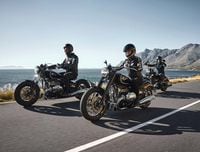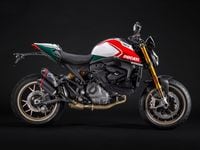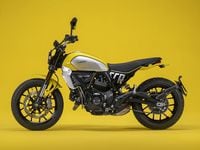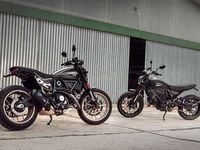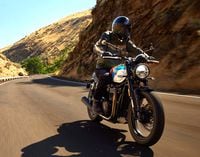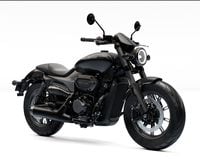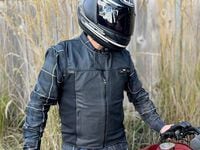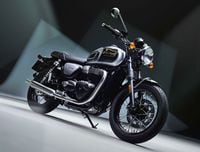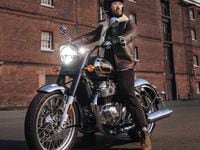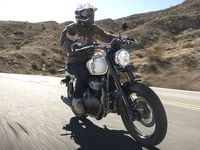We don't require much of an excuse for a road trip around here. A little two-lane country byway inevitably seems like a better place to ply our trade than our 17th-floor offices in a Los Angeles high-rise.
"Hey, boss, I'm evaluating that new polish, so I gotta go get the bike dirty. See ya in a coupla weeks, OK?"
"Listen, I'm not sure if we got the right spelling on the name of this guy from Tennessee. I'll just ride over and check, if that's all right."
"You know, if we set up the opening shot of this bike in front of the Liberty Bell in Philly, we could make a great statement about the freedom of motorcycling..."
Not all of these ideas get approved, unfortunately. However, sometimes we can get in 1000 miles on a good weekend without asking for a hall pass. And Elvidge does have a 400-mile commute to the office. (She doesn't get in every day.) But any valid reason for riding toward the horizon always merits our attention.
We couldn't be denied this time. The motorcycles we had assembled for this project demanded a couple of thousand miles on the road to fully appreciate their subtleties and completely evaluate their long-term comfort. We call them "touring cruisers." Identifiable by their large windshields and hard saddlebags, they live on the plush end of the cruiser spectrum, more civilized than the wild ones and even more long-haul-ready than bikes with leather bags and small windshields. The new subcategory of similar bikes with trunks and stereos, which we call "cruising-style tourers," fit on the cushy side of these bikes but come a bit closer than the all-out touring bikes such as the Gold Wing and Voyager.
Three motorcycles mustered for our call to arms. Harley's Road King, Honda's Valkyrie Tourers and Kawasaki's Nomad signed on for the trip. We also brought Honda .C.E. Tourer, and 1100 V-twin. Since the A.C.E. isn't a direct competitor to the big bikes, we treated it separately. We would have liked to include Yamaha's Royal Star Tour Deluxe, but 1999 models were not available. No matter, it hasn't changed since we last checked out the class (and was soon to be phased out).
The three big bikes we rode were essential to our mission, though. The Honda Valkyrie Tourer grabbed top ranking last time (April '97) we matched up touring contenders, so it sets the standard. Harley's new 1450cc engine qualifies as a major revision to the Road King. Kawasaki's entry in this class, the Vulcan 1500 Nomad, is new, having been introduced last year as a '99 model. With these three key players, plus Honda's A.C.E. Tourer and our long-term Yamaha Road Star for photo duty and a change of pace, we were ready to roll.
Touring in January limits your options however, even if you are starting from Southern California. We can ride up the coast and hope the Pacific isn't brewing any rain, or head east through the deserts along the Mexican border. We decided on the latter.
Load 'em up
Although we switch bikes at every fuel stop, everybody is assigned one to pack on initially. So the evening before we departed everyone had to see how much they could wedge into one bike's saddlebags. When we assembled next morning by the dawn's early light, the Harley rider looked somewhat dour about her packing accommodations but everyone else was happy.
Harley's hard bags are sturdy and easy to pop off for cleaning (just loosen two quarter-turn fasteners inside each one). But bulges to clear other components on the backsides consume much of their apparent capacity. The tops pull off completely but large tether straps retain them in case if you forget to latch or latch them incorrectly. Installing the lids requires a two-step drill. First slip hooks on the tops around tabs on the backs of the bags. Then ease the lids into position (which they can be cranky about if the bags are overstuffed), and crank them down with the large cam-type latches on the outside faces of the bags. The Road King's bags permit you to choose to lock or not.
None of us preferred the H-D bags to the bags on the Honda. (The A.C.E. Tourer and Valkyrie bags have nearly identical bags.) Honda's hard bags offer a reasonable volume and are easy to work with. The tops hinge at the front, so they won't blow open if left unlatched. And you can carry an oversized item too big for the bags by simply strapping the lid down on top of it. The latches can be left unlocked. Our only complaints are that the tops seem a bit flimsy and that there is an unsightly seam running down the back.
A majority of riders rated the Nomad's innovative bags as their favorite design. Looks were certainly part of it. Their shape is pretty and complements the looks and shapes of the rest of the motorcycle. The trim strips on the sides are more than an art-deco touch to lend some nostalgia. They can also protect the sides from scratches, something that befell our Valkyrie. But the most unusual feature is the opening. Instead of opening at the top, the sides open on hinges at their bottoms. This makes gear stuck at the bottom more accessible than with the top-opening bags but it also makes it tough to stack small items in the left bag, since they tend to fall out. We learned to pack the Nomad bags with one or two large bags or other items in the left bag and the smaller bits in the right side, where they lean into the bag. The optional lift-out liners or other similar soft bags would be high on our list of accessories. The left bag has a document pouch, which we wish was in the right side where it's easier to reach at roadside. To be sure that the Nomad's saddlebags couldn't be left unlatched, Kawasaki designed the locks so that they must be locked when closed. You need the key to open a bag, and you must leave the key in the lock to close the bag again. This requires pushing the cover shut, lifting the latch handle, then turning the key to lock it. The design means that the tops are clear for racks, a perimeter guard rail might interfere with the covers. These bags are about as capacious as the Hondas' but packing them was easier for most of us because of the large openings.
All three brands of bags' locks use the ignition key and all three sealed out water well, unless they were overpacked so that the covers bulged.
With a range of temperatures awaiting us, we needed a variety of clothing to adapt -- more than the bags would swallow. Strapping tail bags and duffels on the passenger saddles posed a variety of challenges. The Valkyrie has a backrest but few other points to anchor bungees. It posed the greatest challenge for extra bags. Because its fender rails are open at their bottoms, the Nomad will accept a bungee hook anywhere along the length of the rail. Both Nomad and Road King have forward saddlebag guards on which to hook bungees. The rear portions of the Road King's rails are also open at the bottoms, and it also has an extension loop that runs back to the license plate for an additional anchor point.
To adjust for this added load, Kawasaki and Harley allow you to pump some air into the rear shock assemblies, effectively stiffening the spring rate. Harley uses a single valve to fill both shocks. The Kawasaki has two valves, one on each shock. Kawasaki also provides four steps of rebound-damping adjustment. Simply turn the top of the assembly. You can adjust spring preload on the Valkyrie's shocks mechanically.
Move 'em out
With the preliminaries out of the way, we pointed ourselves east and opened the throttles. Our first day was devoted to getting as far from L.A. as possible and getting a feel for the bikes. The day's roads were virtually all fast four-laners.
Running 100 miles between gas stops, we had time to get well acquainted with the riding positions of our traveling trio. The Harley handlebar makes all but very long-armed riders lean forward slightly, but the others keep you upright. Long-stemmed Elvidge said the Harley gave her the most leg room; she ranked it and the Nomad tops, as did other long-inseamed testers. Shorter riders voted the Valkyrie's riding position, with its pegs set rearward and its wide bar, as their favorite. Those in the five-nine to five-eleven range favored the Nomad, which brings its floorboards back enough to let you get some weight on it without cramping your legs, which felt somewhat overextended on the Harley. None of our five riders took a strong dislike to the riding positions of any of the bikes, however.
The width and shape of the Valkyrie bar made it slightly awkward for most riders when making tight turns at low speeds. The other two bikes were the rides of choice during photo sessions, when we had to stop and turn around frequently on narrow roads.
Everyone preferred the Nomad rear-brake lever position to the Harley's, which was slightly awkward to reach quickly. Because the Honda has footpegs rather than boards, its pedal is easy to cover, but even its wide pegs don't offer anything like the foot-position flexibility of floorboards. Riders with small or arthritic hands appreciate the adjustable handlebar levers on the Nomad. Just push the lever forward and turn the adjusting-cam knob with your thumb to select one of five positions. This can pay significant dividends in clutch, and especially, brake control and permits you to reposition it when you change to heavier or lighter gloves.
Another element that immediately begs notice on a traveling motorcycle is vibration. Again, all three rate well in this regard. Rubber mounts isolate the rider from all but very low-frequency vibration on the Harley. The engine shakes, but most of the rest of the bike is insulated from it except at idle. We'd say it was a smooth machine but the other two are actually smoother.Kawasaki's counterbalancer system checks vibration before it can escape the engine. There is a mild shake at low rpm that vanishes as revs pick up a little. Thus you get the exhaust beat of a big V-twin without the destructive shaking. It feels silky on the highway.Honda's opposed six is naturally smooth and doesn't shake at any speed. The design could cause a torque reaction that would make the bike lean to one side when the engine was revved, but the designers eliminated that by spinning other components, such as the alternator, in the opposite direction.
Chill 'em out
We were up before dawn the next morning to catch the early light and get in some miles. With temperatures in the 30s overnight, the engines had to start from stone cold. It was no problem for the Valkyrie, which awakened immediately with nothing more than application of its handlebar-mounted choke lever. The V-twins were groggier. Both were reluctant to run initially; we had to play with the choke knobs and throttles for a few minutes before they would continue to run well enough to pull away. Once warm, the Nomad ran smoothly, but the Road King continued to surge and hesitate, particularly at low to moderate speeds, as long as the air was cold. This problem persisted even at higher (up to 4000 feet) altitudes. If we were buying a Road King and planned to use it in cold weather, the fuel injection (available only on the Classic version) would be mighty attractive.
Our morning ride led us along almost deserted two-lane roads, and we took the opportunity to compare the bikes' acceleration from highway speeds. With the most displacement and the most cylinders, the Valkyrie was the clear and unsurprising winner in any performance contest. It doesn't need much room between oncoming vehicles to zip past a truck. Whether we went through the gears or simply rolled open the throttles in top gear, the Valkyrie immediately showed the other two its taillight, which shortly thereafter disappeared from sight. We expected the Road King to pull smartly away from the Nomad, but the difference turned out to be relatively minor with the Harley just easing away. If a significantly heavier rider was on the Road King, its top-gear acceleration advantage was insignificant.
The Nomad and Valkyrie give slightly smoother throttle response than the Harley, which is noticeable most at in-town speeds. The Road King scores some points for its stirring exhaust sound, although the Valkyrie's quick-revving growl also raises some pulse rates. The Nomad sounds much like the Harley just a bit more muted. The rapid-fire cadence of the Honda makes some riders reach for a sixth gear on the highway because the engine sounds busy. Although it isn't spinning particularly quickly, the engine gives that impression.
Fill 'em up
On these remote roads, fuel mileage became an issue. With few gas stations to start with and some of them closing in the face of the EPA's requirement to replace their underground tanks, riders of some of the bikes were looking mighty nervous by the time we found a functioning fuel facility. Not the Harley rider, however. With five gallons in the tank and typical highway fuel consumption of 40 mpg, the Harley never needed reserve. The Honda, with 5.3 gallons at 34 mpg on the highway was second best, while the Nomad, with 4.8 gallons, consumed at the rate of 35 mpg, was the first (aside from the A.C.E.) to switch to reserve, usually before it had gone 120 miles since the last fill-up.
Since we often weren't sure how far we had to go to get to the next gas station, we made a point of getting the tanks as full as possible. This turned up some other issues. If you quit pumping gas into the Valkyrie the first time gas rises into the filler neck, you are short-changing yourself. If you are patient and take another minute or so to pump in small amounts and let them settle, the tank will take another three-quarters of a gallon. The Nomad filled right up smoothly, but carries a warning to avoid filling past the baffle plate in the neck. Doing so may flood the evaporative canister and make the engine quit. In our zeal to get all possible gas on board, we did overfill it a few times without any untoward consequences but we have seen it happen. In fact, that scenario or something like it plagued the Road King. Although it carries no warning, if filled even up to the plate in neck, the Road King would repeatedly die when it got back underway. Combined with the cold-weather missing, this affliction confounded us at first, but we eventually learned to leave a little air space in there or dump out a bit of fuel if the engine quit.
With those long legs between gas stations, we also got to know the saddles. Everybody rated the Nomad or Valkyrie the best place to plant yourself for a long ride, with the other second. Both bikes' saddles are flat, roomy, and endowed with enough padding of the proper density. Both also rise behind the rider for some additional support. The Harley seat, though not too bad, was unanimously scored last. Its slightly crowned shape was part of it, but the padding is also a bit too soft.
We didn't take passengers along on the trip, but those that we introduced to all three bikes in town preferred the Valkyrie for its backrest and generous saddle. The Nomad was second, winning points for its floorboards and saddle comfort. Passengers also rated the Harley saddle last because it was narrow, lacked a backrest and got uncomfortable quickly.
Show 'em off
On our third morning we saddled up and rode into Tombstone, which was a popular destination for cruisers that day. Several other Valkyries and A.C.E.s had moseyed into town and there were a couple of Harleys at the hitching post. But after we rode into town, folks were all hankering for a look at the Nomad. A few folks reckoned that it was the purtiest store-bought bike to ever roll past Boot Hill.
No doubt about it, the Nomad is set to stun. The big engine on the Valkyrie sometimes gets attention first, and there are still people who can't see farther than a Harley-Davidson logo. But when people stop and give each bike a long look, the Kawasaki gets the longest, most admiring looks from the most people. Everything works visually. The lines and proportions strike the right note. The details have been carefully attended to. Just look at the windshields of all three bikes. The Nomad brackets and supports are graceful, fully chromed and polished front and rear, with a Vulcan logo adorning the front. The back of the Valkyrie hardware -- the part the rider has to look at all day -- is not polished. Or consider fasteners. Kawasaki's wear chrome or covers. Many of Harley's nuts and bolts look like they belong on farm equipment. That wrinkle-finish paint is also getting old. People are rightfully surprised when you tell them that the Nomad is the least expensive of the threesome. Sure, both of the other bikes have nicely executed components -- the headlight nacelle treatments of both, though different, were frequently cited, the studded, embossed Harley saddle, the tapered mufflers of the Valkyrie -- but the overall levels of finish and design were generally considered tops on the Nomad.
Parking them and lining them up also invites comparisons of detail features. The fork-top instruments of the Valkyrie, though not as stylish as the others, ride close to your line of sight as do the warning lights in the headlight shell. We also like having a tachometer, which neither of the others offers. The tank-top speedos of the Harley and Kawasaki suit the style, but an illuminated warning light will probably escape your notice until you look at the speedometer, which involves taking your eyes off the road. Tank-top speedos also use space that would otherwise hold fuel. At least the Harley and Kawasaki speedos aren't as far rearward on the tank as Yamaha's speedos on the big Stars. Both bikes also give you a fuel gauge, which the Honda lacks.
You get self-canceling turn signals on both the Kawasaki and Harley. The H-D signal system also doubles as a four-way flasher; just push both buttons at once. We still prefer single-switch signal operation though. The Road King's ignition switch design and placement gets our vote in that department. Located just behind the speedometer atop the tank, it can be unlocked and the key removed, or you can turn it on and lock it so that it automatically locks when shut off. A hinged cover snaps over it to keep out dust and water. Honda's ignition switch location, just under the right rear corner of the tank, was our second choice, with the Nomad's, up under the left side of the steering head, last. Honda's handlebar lever choke operation is more convenient than the knobs on the other two. Harley's knob, in the middle of the engine's V, is more accessible than the Nomad's, which is just under the ignition switch on left. All three have separate fork locks.
Kawasaki's helmet locks, mounted on the saddlebag guard rails, were more convenient than the Valkyrie system, which uses a loop of braided steel cable that attaches to a hook under the seat, which must be unlocked to lock or unlock a helmet. However, with a longer cable, you can also lock a jacket to the bike too. The Road King has no helmet lock. It also lacks even the modest tool kits of the other two. This bit of stinginess by Harley is unfortunate because it is the bike most likely to benefit from a tool kit. None of the bikes' horns are worth much. The shape of Nomad mirrors (taller on the outer edges) prompted enthusiastic remarks from more than one rider.
The Road King is the only one with front and rear crash bars, which aren't likely to offer any actual protection in a real crash but might save a few pieces in a parking lot tip-over. Our Road King was also fitted with the optional wire-laced wheels in place of the standard cast hoops. We would avoid wire wheels on a touring bike because they require tube-type tires, which are more prone to blow out when punctured and are must more difficult to repair on the road than tubeless tires (which both the other bikes use). The Harley also has standard whitewall tires.
Head 'em up
From Tombstone we turned north, skirting Tucson and Phoenix, heading for the red rocks of Sedona. Darkness fell, the terrain rose, and the temperature dropped back into the 30s. We were glad for our windshields now, even if they did cast a few reflections. Deer and coyotes dashed across the road occasionally to keep us alert.
For effectively bunting the passing air away from the rider, no other shield matches the Valkyrie's (although the A.C.E. Tourer's was close). The Valkyrie windshield is wider than the others, and it minimizes buffeting from wind rushing past it. Both the Harley and Kawasaki have strong streams of air blowing under the windshields and up. These updrafts not only reduce the wind-deflecting effects of the shields but can blow water or dust up into your helmet or behind your glasses. The Honda produces a larger still-air pocket than its rivals and made the Valkyrie very popular on cold rides. Most riders also complained of excess buffeting behind the Nomad's windshield. For some it was a significant annoyance.
Of course, that cozy still-air pocket created by the Valkyrie windshield can be a detriment during warm weather, especially because the big engine produces a fair amount of heat. We thought the cylinders made great foot warmers at 37 degrees, but owners complain of the heat during summer. There are other drawbacks to windshields. One is distortion. All motorcycle windshields create a little, but the Harley distorts quite a bit. Distortion near the top of the shield made lines on both side of the road appear to turn toward the center more than they did, which could be disorienting. Unless you are six feet or taller, we'd recommend cutting this windshield down. The Valkyrie shield is slightly taller, but its optics are excellent, even better than the Nomad.
The Nomad windshield has provisions for about two inches of adjustment, which was welcome. However, Harley can go one better. Pull two clips, and the Road King's shield and most of its bracketry lift right off. This turns the bike into a boulevard cruiser in a matter of seconds.
All the shields create some glare. The Valkyrie's made the most during the day, when sun reflected off the chrome gas cap and the chrome bezel around it, putting glare just about in the rider's line of sight. There was a smaller amount of instrument lighting reflected at night. The Harley also had some daytime reflection, although farther below your eye level. Both it and the Nomad had little nighttime glare from the speedometer lighting.
All three bikes have good forward lighting, which we appreciated with wildlife dancing across the road. The Valkyrie headlight performed slightly better than the other two. The spotlights on the Road King help to spread the lighted area slightly but don't have a lot of reach. Working dimmer, turn signal and spotlight switches can sometimes be a chore when you are wearing bulky cold-weather gloves. Fortunately, the controls of all three bikes operated smoothly with heavy gloves.
Run 'em around
We spent the next day riding locally, and we got to cruise around Sedona and Oak Creek Canyon without the usual loads of gear. This was hard-core cruising duty: low speeds, engines loafing at low rpm, soaking up the breathtaking beauty of the local geology, and, as Cherney remarked, "getting in touch with your inner crankshaft."
These three open-road runners readily adapt to urban duty. All three make strong low-speed power. They can pull away from a stop with just a suggestion of throttle, and happily trickle through side streets at engine speeds below 2000 rpm. Add predictable, low-effort handling at walking speeds and you get machines that are as manageable in town as they are on the interstate, although the Harley and Kawasaki had a slight edge in this role. With their capacious saddlebags, all three are great grocery getters or daily briefcase toters. The Honda was slightly more awkward when we were paddling around trying to park them, in part because its footpegs get in the way of your legs.
All three bikes consistently shifted smoothly and positively, although the Harley is still somewhat noisier than the others during gear changes. No one registered any complaints about gear staging. Harley's neutral position sometimes required a bit of fishing, but it was a snap on the Nomad, which with Kawasaki's neutral finder feature automatically stops in neutral when you upshift from first gear at a stop. The Valkyrie's clutch was judged the best because it requires a light pull and engages most progressively. The Nomad clutch offers a light pull and a wide, adjustable lever blade but somewhat abrupt engagement. The Road King requires a strong pull on its wide-blade lever and has a shorter engagement span than the Honda. Harley's cable operation also permits a degree of adjustability.
Lean 'em over
We rolled out of Sedona before the sun arrived the next morning. Temperatures hovered around freezing as we rode through Cottonwood, the revived ghost town of Jerome and Prescott, then wound down to the desert floor again. Even though our face shields were frosting up in places, we quickly forgot the cold as our attention was absorbed by the writhing road, which meandered up and over mountains through the Prescott National Forest.
The twists of the road invigorated everyone, even the unshielded rider on the Road Star. We only paused to attend to the Harley, which stopped first because the fuel tank was overfilled and then because a bolt in the shift linkage had backed out. That was the biggest problem we had with the Harley in 2000 miles (though it would have stopped us if we hadn't brought our own tools). We also discovered that the knurled metal knob atop the dipstick had pulled loose from the rubber cover beneath, which made oil-level checks messier and a bit more time-consuming. None of the other bikes had any mechanical problems at all. The Harley consumed almost a quart of oil. The Nomad (which wasn't fully broken in when the ride started) used about half that much. The Valkyrie used virtually none.
Our romp through the mountains focused attention on handling and, during the downhill run, on brakes. You might expect these hefty-looking machines to get downright truck-like on winding roads, but, as a class, their handling is actually better than other cruisers. You expect good stability on the highway, and they all deliver that. But you might not count on retaining that stability and surefootedness while leaned over at 70 mph in a downhill sweeper with bits of undercarriage leaving long curving gouges in the pavement. Yet all three create confidence in exactly that situation as well.
The Nomad has the most responsive steering. It turns the quickest, though the Valkyrie is equally precise. The Harley, though not far from the other two, seems the least precise. (These heavy bikes are even more sensitive to tire pressures than other classes of cruisers, and it pays to frequently check that they are fully inflated.) Some of the Harley's imprecision results from suspension that isn't as well controlled as the other two. Our Harley had about 6000 miles on it when the ride started, so its suspension may have begun to wear a little. (The others started with less than 1000 miles each.) The Valkyrie suspension earns top marks, giving great control through corners, even bumpy ones, and soaking up the blemishes, pits and pockmarks of road acne with grace. The Nomad gets close but can't quite match the suspension performance of the Valk. With the least travel and less damping control than the others, the Road King delivers the roughest ride, but again, it's not that bad. For those who take cornering seriously, the Valkyrie provides the most cornering clearance before its pegs touch the pavement. The 'King and the Nomad drag their floorboards loudly, though the Kawasaki does so slightly sooner than the Harley.
After our long, fast run down the winding road cascading to the desert, only the Kawasaki rider had nothing but kind words for his brakes. Our Valkyrie was slightly mushy up front and its brakes had faded slightly, demanding a bit more effort at the lever. Of course, it also entered corners faster than the others. The Road King brakes require more pressure and provide less feedback than the other two. With triple discs all around, all three bikes have the braking power to make strong stops from these speeds. The tires also give you more braking traction than most OE cruiser rubber.
Bring 'em in
Before crossing the Colorado River back into California, we stopped for lunch at a little backwater truckers' cafe. Over enchiladas and chile rellenos, we sought to find a consensus about which one was the winner, but there wasn't one. Three of our five riders picked the Valkyrie Tourer as their favorite. One of them placed the Harley second. Both the others favored the Nomad ahead of the Valkyrie. Four listed the Harley last, but without strong prejudice.
You need to pick what is important to you to make the best choice here. The Valkyrie is an engineering marvel, powerful, smooth, elegantly suspended and capable of covering lots of ground effortlessly. Passengers prefer it. We like its unique look, but we wish it was finished with more of an eye on detail. It's not quite as handy in traffic as the other two, and the engine also makes the rider a bit uncomfortable in heavy traffic on a hot day.
The Nomad is one of the prettiest bikes on the road, its comfort, flawed by buffeting past the windshield, is almost on a par with Valkyrie for most riders, ahead for a few. Slightly short on power compared with the others, it is nonetheless capable of transporting you and a friend from horizon to horizon easily with a more relaxed cadence than the Honda. You will have to stop for fuel more frequently than with its competitors though. It is a more willing workaday ride than the Valkyrie and turns more heads on cruise night.
The new engine has given the Road King a bit more power, though we'd consider the Classic model with its fuel-injection, which would probably also sidestep the cold-weather surging. Although it runs close to the Valkyrie Tourer and Nomad, the Harley performs few duties better than the other two. Fuel consumption and range are its biggest functional advantages. It also counts low-speed handling, power and almost unlimited accessory options among its strengths. Passenger comfort is probably its biggest shortcoming but there are a variety of points that irk most riders, such as the windshield distortion. However, the Road King suffers mostly in comparison with the other two. It is a bike that we enjoy riding, both for long distances and around town. No one here would turn down the opportunity to ride to Philadelphia if the Road King was the only option, but we'd all lobby for one of the other two if they were available.
**IN BRIEF
HARLEY-DAVIDSON ROAD KING
High Points: ** Best mileage and range, best sound, includes spotlights and front crashbars, exceptional accessory availability.
**Low Points: **Ran rough in cold weather, troublesome windshield distortion, least popular with passengers, price.
**First changes: **Change or cut down windshield, get a tool kit, change seat if carrying a passenger.
**HONDA VALKYRIE TOURER
High Points: **Terrific power, very smooth, handy saddlebags, exceptional windshield, distinctive style, best passenger comfort, best saddle.
**Low Points: **Engine heat in hot weather, many pieces bait the style police, fewer accessories than others.
**First Changes: **Remedy some styling flaws, bag liners, shorter riders should shorten windshield.
**KAWASAKI NOMAD
High Points: **Great looks, smooth, comfortable ride and position, innovative and handy saddlebags, good low-speed manners. lowest price.
**Low Points: **Windshield buffets. most limited cruising range.
**First Changes: **Passenger backrest to ride two-up.
**RIDING POSITIONS
Rhonda Hoffman: **Although I live in Virginia, the Nomad made me feel right at home on the roads of Arizona. The Kawasaki was as comfortable as my favorite recliner. The roomy floorboards and adjustable levers created an ideal riding position. I had no complaints with the seat either.
The only bumps in the road for the Nomad are the windshield's tendency to blow wind right into my helmet and the bike's less-than-blistering acceleration. Give me the windshield for a few days and I'll fix that problem. The Nomad easily maintained highway speeds, and who is in a hurry while riding around the beautiful vistas of Arizona? If I were, a few go faster-goodies would easily remedy that itch.
And did I say how downright pretty it is? Certainly better looking than my recliner or any of the other motorcycles on our ride. At the gas pumps, I noticed onlookers gazing at the Nomad, confirming what I already knew. In short, I didn't tire of riding the Nomad or looking at it. It's my clear choice.
Hoffman is a motorcycle painter and customizer in Richmond, Virginia. She gets e-mail at: _ PayntGRL@aol.com.
**Andy Cherney: ** I wanted to love the Nomad, Rubenesque curves and all, but all that weight is overkill. The saddle, floorboard and shifter positioning add up to sweet luxury, but I couldn't abide the anemic throttle response and harsh windshield buzz. I will say this for the Nomad: It has awesome mirrors. I could see all of the road. And those beautiful saddlebags...breathtaking. I just wish Kawasaki would add 20 horses -- we might have ourselves a new champ.
Speaking of champs, please welcome...the Honda! My choice in this comparo, the Valkyrie's like an elephant in ballet slippers -- it's big and bulbous but incredibly nimble for a pachyderm. There's a windshield the size of Texas, offering coddling Mom would approve of. Power from the monstrous flat-six motor, though abrupt, goes on forever, and the brakes are incorruptible. The problems I had were with the seating position. The saddle is like a wok, and why doesn't this thing have floorboards?! Feet dangle at precarious angles, searching for the shifter and the pegs are too far back for any real comfort. That notwithstanding, I'd still pick the Valk for a long trek -- just not the boulevard.
We know the Harley's rough but it's got tons of personality. The Road King fit me fine -- the floorboards are spot-on, and the entire design is well-integrated, unlike earlier generation Harleys. Hard bags fit nicely and packing is a breeze (though locking them isn't). The Fathead engine finally gives Harley some real spunk and it's as stable as a truck (but that's how it handles too). The brakes are there but use both of 'em -- especially downhill. And heed this disclaimer: Personality means nothing if it strands you on the side of the road.
In a nutshell, if I was chalking up serious mileage, I'd find myself on the Valkyrie.
**Jamie Elvidge: ** I live for long rides. Really. But a long ride gets profoundly better when you're on a bike built for it, and I'll pick a touring cruiser over a non-touring cruiser every time. All three of these bikes are among my favorites, and they're all up for the job. With the Valkyrie and Nomad there were no surprises. The Honda continues to be a stand-alone motorcycle for me. It doesn't fit in any comparison, expect maybe one that includes hovercraft. It's very good at one thing: being different -- and better -- than everything else. So it's my first pick.
And I loved the Nomad. It's a well-balanced cruiser and it's got attitude, which I think the Honda lacks.
The thing that knocked my electric socks off on this tour was how much I loved the Road King. It nearly ousted the Nomad from second place. It swept me off my feet. A Harley would normally have to run into me at speed to do that. I just loved it. It was fun to ride, fit me well and performed to my admittedly Japanese-jaded standards. I've never said, "If I were going to own a Harley..." but I'm saying it now. Pass the tempy tattoos.
**Art Friedman: ** This is my very favorite class of motorcycles. The touring cruisers have it all. They are comfortable, good-looking, capable around town and on winding roads, and offer the two most important extra amenities -- saddlebags and windshields.
I sort of took it for granted that the Valkyrie would be my pick of the litter. It delivered all I expected with great power, a unique and thrilling sound, an excellent saddle, terrific handling and suspension, and the best windshield in cruiserdom. I had high hopes for the Harley with its new engine. But though the Road King is my favorite Harley, it's not my favorite touring cruiser. The glitches in the engine performance were annoying but the riding position, saddle and awful distortion of the windshield proved to be significant shortcomings for me. And both of the Fathead-powered Harleys we have tested have still required more mechanical attention than their counterparts. Add the funky saddlebags, uninspired detailing and the high price that's not justified by build quality and my interest shifts to the others. But, maybe most of all, I don't want a me-too motorcycle. Who wants to be the 19th on their block to own a Road King? Buying a Harley when there are better choices just shows lack of imagination.
I expected to like the Nomad but I didn't expect to keep liking it more each time I rode it. It was as comfortable for me as the Valkyrie but more responsive in traffic or tight sections of road. I noticed but wasn't annoyed by the windshield buffeting, and I liked its adjustability. It is definitely the prettiest bike here.
By the time we got back from our five days on the road, I hadn't decided whether I preferred the Honda or the Kawasaki. I pondered it all weekend, then Monday rolled around. Both the Valk and the Nomad were in my garage. (I love this job!) I realized I was looking forward to riding the Kawasaki to work while the Honda seemed less appealing when heavy traffic was on the agenda. That settled the issue. I ride in traffic every day but I don't go touring even every weekend.
The Nomad gets my solid endorsement. The fact that it costs less seals the deal.
_Friedman gets e-mail, even when he's on tour, at _ ArtoftheMotorcycle@hotmail.com.
HARLEY-DAVIDSON ROAD KING
Though many will identify the Road King as the prototype for the other bikes we compare it to, the King could also be considered the prototype Harley. Before H-D tested the waters for more elemental cruisers with its Super Glide almost 30 years ago, its big twin was the Electra Glide, and the Electra Glide was typically configured much like the Road King is now, with a big windshield, saddlebags and a floorboards. The seat was bigger, but the profile was otherwise very much like this. The fact that many of today's riders first became motorcycle-aware during that era probably helps explain the popularity of the Road King today.
Like the other members of what Harley calls its touring family, the Road King gets the new 1450cc engine, a modern engine that retains the style and tradition or earlier H-D big twins. Called the Twin Cam 88 by Harley (a.ka. Fathead), the new engine brings an additional helping of horsepower, which is most welcome in Harley's touring oriented bikes. The twin-cam configuration is less important than the revised design and manufacturing processes that the engine introduced. Those aspects of the engine design promise greater reliability, speedier assembly (which should help Harley increase total production), easier maintenance, and quieter running. Despite its all-new design, the 1450's design parameters follow the traditions of previous Harley Big Twins: air-cooling, overhead valves operated by pushrods and hydraulic lifters, a 45-degree cylinder angle, with a single carburetor supplying mixture from the middle of the V, dry sump, and chain primary drive on the left side running to a separate (and also new) transmission case. The tranny uses the same shafts inside the new case though. Since adopting them over two decades ago, Harley raised our expectations for toothed belts as final-drive mediums, and the Fatheads all use them.
Its Harley-trademark headlight nacelle that blends into the upper fork cover readily identifies the Road King. Spotlights bracket the headlight. The windshield attaches via unique mounts that allow you to unclip it in seconds. The 5.0-gallon fuel tank appears to have dual filler caps, but in an un-Harley-like bit of fakery, the left one turns out to be a dummy that simply houses a small fuel gauge.
The one-piece saddle features embossed logos. This model of the 'King has hard-sided fiberglass saddlebags and a 40mm carburetor, while the Classic version gets leather bags and fuel injection. Both ends have cast wheels and are completed with fender-tip lights.
Specifications
1999 Harley-Davidson Road King
Designation: FLHR
Suggested base price: $15,065, $15,330 in CA
Standard colors: Black
Extra cost colors: Red pearl, blue pearl, orange pearl add $265; two-tone blue/silver, orange/silver, red/black, green/black add $660
Standard warranty: 12 mos., unlimited miles
Recommended service interval: 5000 miles
ENGINE & DRIVETRAIN
Type: Air-cooled, 45-degree tandem V-twin
Valve arrangement: OHV, 1 intake valve, 1 exhaust valve; pushrods, hydraulic adjusters
Displacement, bore x stroke: 1450cc, 92 x 102mm
Compression ratio: 8.8:1
Carburetion: 1, 40mm Keihin CV
Lubrication: Dry sump, 4.0 qt
Minimum fuel grade: 87 octane
Transmission: Wet, multiplate clutch; 5 speeds
Final drive: Toothed belt, 70/32
CHASSIS
Wheelbase: 63.5 in.
Overall length: 95.6 in.
Rake / trail: 26 degrees / 6.2 in.
Wheels: Cast alloy, 3.0 x 16 in. front and rear (laced wheels add $320)
Front tire: MT90B16 Dunlop D402 tubeless
Rear tire: MT90B16 Dunlop D402 tubeless
Front brake: 2 single-action calipers, 11.8-in. discs
Rear brake: Single-action calipers, 11.8-in. disc
Front suspension: 4.6 in. travel, adjustable for air pressure
Rear suspension: 2 dampers, 3.0 in. travel, adjustable for air pressure
Fuel capacity: 5.0 gal
Wet weight: 761 lb
GVWR: 1179 lb
Weight bias: 53.1 percent rear wheel
Handlebar width: 34.1 in.
Seat height: 27.3 in.
Inseam equivalent: 33.7 in.
ELECTRICAL & INSTRUMENTATION
Charging output: 507 watts
Battery: 12v, 30AH
Forward lighting: 55/60-watt headlight, dual 30-watt passing lamps, position lights, front fender marker light
Taillight: Single bulb, rear fender marker light
Instruments: Speedometer, LCD odometer/tripmeter; warning lights for high beam, turn signals, oil pressure, low fuel, engine malfunction
PERFORMANCE
Fuel mileage: 35 to 45 mpg, 40.5 mpg average
Average range: 202 miles
RPM at 60 mph, top-gear: 2560
200 yard, top-gear acceleration from 50 mph, terminal speed: 72.0 mph
Quarter-mile acceleration: 14.09 sec., 90.7 mph
HONDA VALKYRIE TOURER
Every conversation about the Valkyrie starts with its engine. Absolutely unique in cruising, that mammoth flat six is imposing, intriguing, eye-catching and exciting. Its almost automotive design springs from its original duty, powering the Gold Wing touring bike. It was something of a shocker when transmogrified for cruising duty. With a brief wave of the hot-rodder's wand, Honda also made its cruiser a musclebike.
Powerful, smooth, and reliable, the Valkyrie invited you to go traveling, even before Honda started equipping it for that purpose. The Valkyrie Tourer, introduced for '97, broadened that invitation with a windshield and saddlebags added to an otherwise standard Valkyrie. This year Honda went further still, making major changes to create the Valkyrie Interstate, which takes the flat six almost back to its Gold Wing form.
The basic Valkyrie garnered top marks in our Flagships comparison last August. Power, handling, comfort, great brakes and a singular, self-confident style helped it to best seven other brands' top cruisers in the eyes and the seats of the pants of our testers. The conversion from basic Valkyrie to Valkyrie Tourer involves nothing more than the addition of a windshield and hard saddlebags. No other parts need to be altered, beefed up or reconfigured to handle the additional equipment and load. Aside from brackets and colors, the bikes are identical.
No one mistakes the Valkyrie for a Harley. That long, flat, liquid-cooled engine with its polished-chrome covers over the single overhead cams on the sides and cam-drive belts in front doesn't make the least pretense of being another air-cooled V-twin. Then there are the carbs with their manifolds curving down into the engine. And the smooth, quick-revving sound speaks more of a highly tuned race car than a lumbering V-twin.
Honda took it own course elsewhere too. The gracefully curving lines of the headlight's eyebrow, the fat upside-down fork legs and the squared-off fishtail-esque style of the removable muffler tips are all originals.
You can see much of the motorcycle's design philosophy in the instruments. Instead of setting them in the trendy but hard-to-see site atop the fuel tank, Honda put the gauges up above the headlight. There is also a tachometer, a rarity among cruisers. It tells you that Honda is serious about performance of this bike.
Specifications
1999 Honda Valkyrie Tourer
Designation: GL1500CT
Suggested base price: $14,199
Standard colors: Black
Extra cost colors: Red/ivory, black/silver, add $500
Standard warranty: 36 mos., unlimited miles
Recommended service interval: 8000 miles
ENGINE & DRIVETRAIN
Type: liquid-cooled horizontally opposed 6
Valve arrangement: SOHC, one intake, one exhaust, operated by rocker arms, screw-type adjusters
Displacement, bore x stroke: 1520cc, 71mm x 64mm
Compression ratio: 9.8:1
Carburetion: 6, 28mm
Lubrication: wet sump, spin-on filter, 4.5 qt.
Transmission: hydraulically actuated wet clutch, 5 speeds
Final drive: shaft, 2.833:1
CHASSIS
Wheelbase: 66.5 in.
Overall length: 100.2 in.
Rake / trail: 32.3 degrees / 5.98 in.
Wheels: Cast, 17x3.5 front, 16x5.5 rear
Front tire: Dunlop 150/80R 17 D206F tubeless radial
Rear tire: Dunlop 180/70R16 D206F tubeless radial
Front brake: 2, single-action dual-piston caliper, 11.65-in. disc
Rear brake: single-action caliper, 12.44-in. disc
Front suspension: 45mm inverted, 5.1 in. travel, internally adjustable spring preload
Rear suspension: 2 dampers, 4.7 in. travel, adjustable for spring preload
Fuel capacity: 5.3 gal., (1.1 gal reserve)
Wet weight: 775 lb.
GVWR: 1166 lb.
Handlebar width: 34.0 in.
Seat height: 29.1 in.
Inseam equivalent: 33.8 in.
ELECTRICAL & INSTRUMENTATION
Charging output: 546 watts
Battery: 12v, 12AH, maintenance-free
Forward lighting: 7-in. 55/60-watt headlight, position lights
Taillight: single bulb
Instruments: speedometer, odometer, tripmeter, tachometer; warning lights for high beam, turns signals, neutral, low oil pressure, sidestand
PERFORMANCE
Fuel mileage: 31 to 38 mpg, 34.0 mpg average
Average range: 180 miles
RPM at 60 mph, top gear: 2990
200-yard, top-gear acceleration from 50 mph, terminal speed: 73.0 mph
Quarter-mile acceleration: 12.95 sec., 101.4 mph
KAWASAKI VULCAN 1500 NOMAD
Unlike Honda, which simply bolted a windshield and saddlebags on its flagship cruiser, Kawasaki made significant changes from the base model Vulcan 1500 Classic when it created the Nomad.
The frame has been beefed up using larger-diameter tubing and lengthened, with an additional quarter-inch between the axles. Steering geometry has been rearranged through the use of a different triple clamp to give 7.4 inches of front-wheel trail compared with the Classic's 4.84 inches. Cast wheels mounting tubeless tires (a wider one in front) offer greater rigidity and load capacity than the Classic's wire wheels. The tubeless tires also offer some resistance to blowouts and may be easier to repair temporarily on the road. An additional disc and caliper on the front wheel supply added braking power to decelerate the additional load Nomads will presumably carry. Air-assisted shocks with rebound damping adjustments at the rear offer a half-inch more travel than the Classic's and raise the height of the deeper, fuller saddle about three-quarters of an inch. The floorboards are moved slightly rearward, and the passenger also gets floorboards on the Nomad.
Those changes plus the addition of the adjustable windshield, side-opening saddlebags and saddlebag guard rails add about 80 pounds of wet weight to the Nomad compared with the Classic, even though they both still have the same 4.2-gallon gas tank. The Nomad's exhaust system, which splits to run down each side to clear the bags better than the Classic's staggered arrangement, may also add a few pounds.
Although the Nomad brought a few innovations to the engine bay when it was introduced, most of them have now been adapted to the Classic. However, the heavier Nomad gets slightly more flywheel mass. Essentially, it is the same liquid-cooled, single-carb, single-overhead-cam, eight-valve 50-degree V-twin that we first saw in the Vulcan 1500 Classic in 1996. Deep finning gives the engine a traditional appearance. A counterbalancer takes the vibration out of the engine at highway speeds and reduces it to a gentle throb at low engine speeds. A large airbox runs through the V and uses round chrome covers on both sides of the engine.
These days, all the bikes based on the Classic -- which now includes the ultra-retro Drifter -- have five speeds. Shaft-drive sends power to the rear wheel. Tank-top instrumentation includes a fuel gauge in addition to the standard speedometer and an array of warning lights.
Specifications
1999 Kawasaki Nomad
Designation: VN1500-G1/L
Suggested base price: $11,999
Standard colors: Red/red, green/green
Extra cost colors: None
Standard warranty: 24 mos., unlimited miles
Recommended service interval: 6000 miles
ENGINE & DRIVETRAIN
Type: Liquid cooled, 50-degree tandem V-twin
Valve arrangement: SOHC, 2 intake valves, 2 exhaust valves, operated by hydraulic adjusters
Displacement, bore x stroke: 1470cc, 102 x 90mm
Compression ratio: 8.6:1
Carburetion: 1, 40mm Keihin CV
Lubrication: Wet sump, 3.7 qt.
Minimum fuel grade: 87 octane
Transmission: Wet, multiplate clutch, 5 speeds
Final drive: Shaft, 2.619:1
CHASSIS
Wheelbase: 65.6 in.
Overall length: 98.8 in.
Rake/trail: 32 degrees / 7.4 in.
Wheels: Cast aluminum, 3.0 x 16in. front, 3.5 x 16in. rear
Front tire: 150/80-19 71H Bridgestone Excedra G703, tubeless radial
Rear tire: 150/80-19 71H Bridgestone Excedra G702, tubeless radial
Front brake: 2, single-action, twin-piston calipers, 11-in. disc
Rear brake: single-action caliper, 12.5-in. disc
Front suspension: 41mm stanchions, 5.9-in. travel
Rear suspension: dual dampers, 3.9 in. travel, adjustable for air-pressure, rebound damping
Fuel capacity: 4.2 gal., (1.1 gal. reserve)
Wet weight: 775 lbs.
Weight bias (front/rear): 56.7 % rear wheel
Handlebar width: 32.5 in.
Seat height: 28.3 in.
Inseam equivalent: 33.2 in.
ELECTRICAL & INSTRUMENTATION
Charging output: 588 watts
Battery: 12v, 14AH
Forward lighting: 55/60-watt headlight
Taillight: Dual bulbs
Instruments: speedometer, odometer, tripmeter, fuel gauge; warning lights for high beam, turns signals, neutral, coolant temperature, oil pressure
PERFORMANCE
Fuel mileage: 23.2 to 38.0 mpg, 34.8 mpg average
Average range: 146.2 mi.
RPM at 60 mph, top gear: 2545
200 yard, top-gear acceleration from 50 mph, terminal speed: 65.9 mph
Quarter-mile acceleration: 15.11 sec., 84.05 mph
For a more recent comparison of the motorcycles in this class, see our 2002 Baggers Comparison.
Additional motorcycle motorcycle road tests and comparison tests are available at the Road Tests section of MotorcycleCruiser.com.










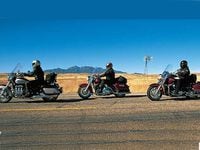
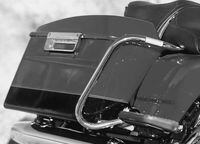
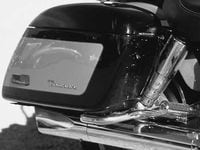
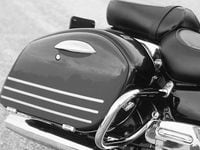
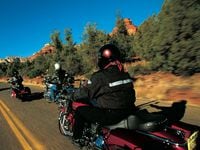
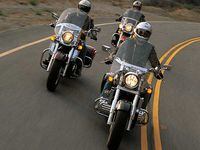
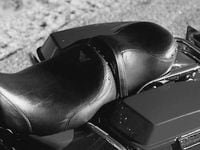
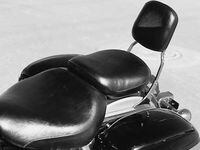
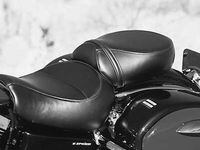
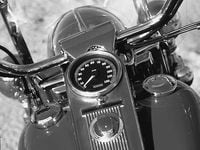
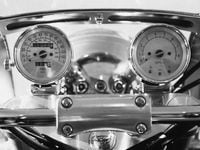
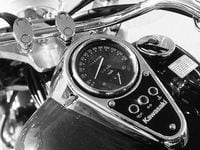
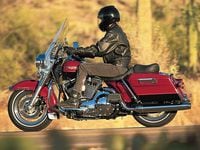
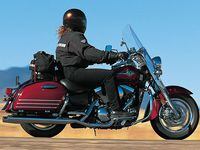
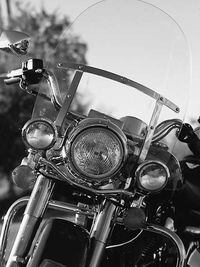
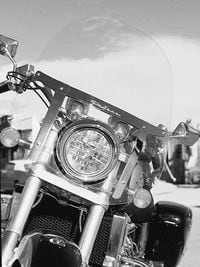
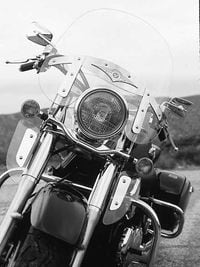
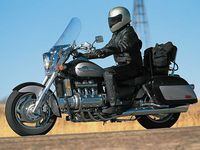

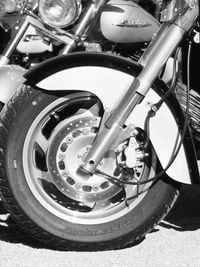
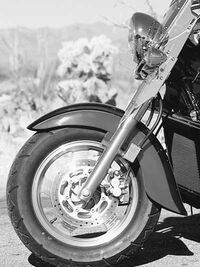
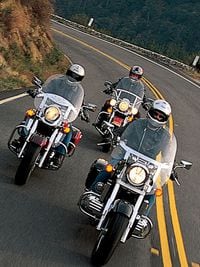
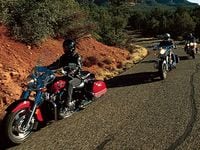
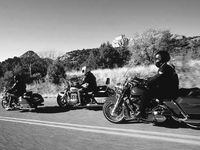
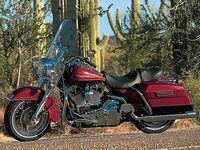
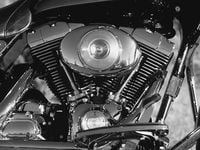
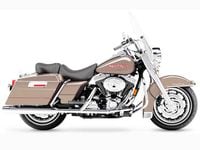
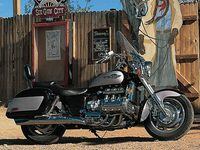
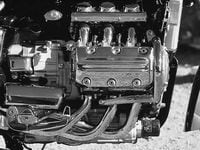
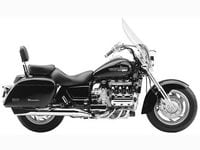
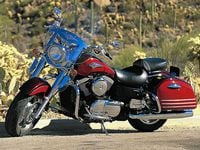
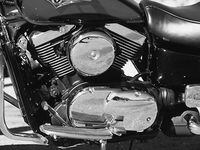
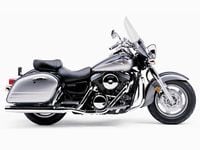
/cloudfront-us-east-1.images.arcpublishing.com/octane/H6Z2IC7WYRBXZNQS4MI3SZ5KPQ.jpg)
/cloudfront-us-east-1.images.arcpublishing.com/octane/IWO5T5PBT5E4HFQ5GK47H5YXR4.jpg)
/cloudfront-us-east-1.images.arcpublishing.com/octane/OQVCJOABCFC5NBEF2KIGRCV3XA.jpg)
/cloudfront-us-east-1.images.arcpublishing.com/octane/F3O2DGLA4ZBDJGNVV6T2IUTWK4.jpg)
/cloudfront-us-east-1.images.arcpublishing.com/octane/ZXYQE3MHLFDSPKNGWL7ER5WJ4U.jpg)
/cloudfront-us-east-1.images.arcpublishing.com/octane/RDF24VM7WVCOBPIR3V3R4KS63U.jpg)
/cloudfront-us-east-1.images.arcpublishing.com/octane/W7RSIBFISNHJLIJESSWTEBTZRQ.jpg)
/cloudfront-us-east-1.images.arcpublishing.com/octane/AERA26ENRNBW3K324YWCPEXYKM.jpg)
/cloudfront-us-east-1.images.arcpublishing.com/octane/YWX3YX7QBBHFXFDMEEEKRG4XJE.jpg)
/cloudfront-us-east-1.images.arcpublishing.com/octane/I7OKI53SZNDOBD2QPXV5VW4AR4.jpg)
/cloudfront-us-east-1.images.arcpublishing.com/octane/IH52EK3ZYZEDRD3HI3QAYOQOQY.jpg)
/cloudfront-us-east-1.images.arcpublishing.com/octane/K2FSAN7OWNAXRJBY32DMVINA44.jpg)
/cloudfront-us-east-1.images.arcpublishing.com/octane/G4XK7JL24FCUTKLZWUFVXOSOGE.jpg)
/cloudfront-us-east-1.images.arcpublishing.com/octane/JJNXVAC27ZCDDCMTHTQZTHO55Y.jpg)
